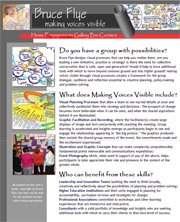 We've all been there: a carefully orchestrated change process is suddenly steered into another direction in the interest of "more action and less talk." Having embarked on an engagement designed to use Appreciative Inquiry and completing a first Discovery session, the decision was made that there would be no topical interviews and a revised schedule had no Dream phase. What happened?
We've all been there: a carefully orchestrated change process is suddenly steered into another direction in the interest of "more action and less talk." Having embarked on an engagement designed to use Appreciative Inquiry and completing a first Discovery session, the decision was made that there would be no topical interviews and a revised schedule had no Dream phase. What happened?Two things come to mind for future improvement: being more circumspect about taking "yes" for an answer, and becoming much more rigorous about jointly developing an agreed-upon change agenda. In this particular incident, AI was warmly viewed as an excellent tool for the issues at hand; however, it's possible that the AI solution was on the table before the task was fully analyzed. For instance, my assumption was that the change agenda had been previously determined as bringing Change, Progress and Renewal to the issue at hand. It was much later that I finally realized the intended message: the issue needs CPR. This is not the positive orientation upon which AI builds its success, and it seems to be a contributor to how things ran off the track.
 The revised approach for this project will move more immediately into specific content and analysis; again, a pressure that many clients face for varying reasons. The choice that has to be made is around the value of a "deeper dive" that creates the capacity for fundamental change. For instance, we know that if new thinking doesn't permeate our conversations, our images don't change and therefore neither will our practices. We know from the Anticipatory Principle that there is huge potential in moving toward what we value as opposed to away from what we dislike. It can also be shown that the creation of images of ideal outcomes reveals alignment in group thinking; recent brain research shows higher levels of creativity in such positive atmospheres as opposed to the usual orientation of problem elimination.
The revised approach for this project will move more immediately into specific content and analysis; again, a pressure that many clients face for varying reasons. The choice that has to be made is around the value of a "deeper dive" that creates the capacity for fundamental change. For instance, we know that if new thinking doesn't permeate our conversations, our images don't change and therefore neither will our practices. We know from the Anticipatory Principle that there is huge potential in moving toward what we value as opposed to away from what we dislike. It can also be shown that the creation of images of ideal outcomes reveals alignment in group thinking; recent brain research shows higher levels of creativity in such positive atmospheres as opposed to the usual orientation of problem elimination.
A pattern that appears in a large body of work is that of a distinct "turn" in collective thinking under certain circumstances. Thomas Kuhn described it as the result of sufficient dissonance; Arthur M. Young showed it as a 90-degree turn, such that the new direction is equally different from its original destination and its source; Drexler and Sibbet describ ed it as a point of commitment, Scharmer as the opening of will, Block as the point at which "the answer to How? is Yes!" Mapping these will often show a "u" or "v" shape, with various levels along the vertical dimension, and to these levels can be added those of the iceberg used in systems thinking.
ed it as a point of commitment, Scharmer as the opening of will, Block as the point at which "the answer to How? is Yes!" Mapping these will often show a "u" or "v" shape, with various levels along the vertical dimension, and to these levels can be added those of the iceberg used in systems thinking.
 ssures present themselves. It's OK sometimes, but when? That's where a careful diagnosis of a situation merits as much attention as the process design itself.
ssures present themselves. It's OK sometimes, but when? That's where a careful diagnosis of a situation merits as much attention as the process design itself.So where might one begin? At a fundamental level, Heifetz's Leadership Without Easy Answers offers a starting point. In describing when to use technical versus adaptive practices, he suggests we consider the extent to which the challenge is well-defined and the likely solution already known. Similarly, Carlson and Bailey describe the use of the processing mode of thinking for when the variables are known, but the application of the flow mode for when they aren't. A diagnostic tool that allowed a designer to chart a client's situation among such markers would be invaluable.
Additional resources can be found in the literature on various approaches. For instance, on the AI Commons can be found advice on when NOT to use AI: predictable, linear process and outcomes are required; problem-identification/problem-solving is the preferred method for change; there is lack of support for passionate dreaming and inspired self-initiative.
The Creative Problem Solving Process may be a place to start with the development of such a diagnostic tool. In what ways might we use that process to design process?


No comments:
Post a Comment